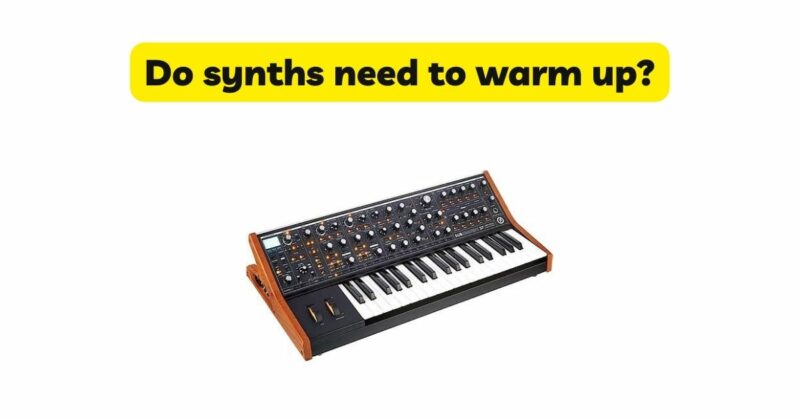The concept of warming up musical instruments before use has long been debated among musicians, and synthesizers are no exception. Some argue that synths need time to warm up for optimal performance, while others claim it is unnecessary. In this article, we will explore the concept of warming up synthesizers, discuss the factors that contribute to the notion, examine the myths surrounding the topic, and provide insights to help musicians make informed decisions about warming up their synthesizers.
Understanding the Concept of Warming Up: The idea of warming up a synthesizer stems from the belief that allowing the instrument to stabilize its internal components and reach a consistent temperature can result in improved sound quality and stability. Proponents of warming up argue that it allows for more accurate tuning, reduces potential pitch drift, and enhances the overall performance of the synthesizer.
Factors Contributing to Warming Up: Several factors contribute to the concept of warming up synthesizers:
- Thermal Equilibrium: Electronic components, such as capacitors and resistors, can be affected by temperature changes. Warming up a synthesizer allows these components to reach a stable thermal equilibrium, minimizing potential temperature-related variations in performance.
- Stability of Oscillators: Oscillators are crucial components in synthesizers that generate sound waves. Temperature changes can affect their stability, potentially leading to pitch variations or drifting. Warming up the synthesizer is believed to mitigate these issues by allowing the oscillators to stabilize.
- Circuit Warm-Up: Analog synthesizers, in particular, may benefit from a warm-up period due to the nature of their circuitry. Analog components, such as voltage-controlled oscillators (VCOs) and filters, can exhibit slight variations in performance until they reach a stable operating temperature.
Myths Surrounding Synth Warm-Up: While warming up a synthesizer is commonly discussed and practiced, there are some myths associated with the concept:
- Duration of Warm-Up: One common misconception is that synthesizers require an extended warm-up period of several hours. In reality, the warm-up time needed for a synthesizer to reach optimal performance is generally much shorter, typically within the range of 10 to 30 minutes. Beyond this period, any perceived improvement in performance is likely negligible.
- Digital vs. Analog: Another myth suggests that analog synthesizers benefit more from warming up compared to their digital counterparts. While analog components may be more sensitive to temperature variations, modern digital synthesizers are designed with stability and temperature compensation mechanisms that minimize the impact of temperature changes on performance.
- Warm-Up for Sound Quality: There is a belief that warming up a synthesizer improves sound quality, resulting in more vibrant or accurate tones. However, the primary factors influencing sound quality are the design, architecture, and overall signal processing capabilities of the synthesizer itself, rather than a warm-up period.
Considerations for Warming Up: When deciding whether to warm up a synthesizer, consider the following factors:
- Personal Preference: Musicians may have personal experiences or subjective perceptions that lead them to believe in the benefits of warming up a synthesizer. If warming up a synthesizer aligns with your preferences and enhances your overall playing experience, there may be value in continuing the practice.
- Environment and Usage Patterns: The ambient temperature and usage patterns of your setup can influence the need for warming up. If your studio or performance environment experiences significant temperature fluctuations, a short warm-up period may be beneficial in ensuring stable performance.
- Time Constraints: In time-sensitive situations, such as live performances or studio sessions, waiting for an extended warm-up period may not be practical. Musicians in these scenarios can consider other techniques, such as monitoring and adjusting the synthesizer’s parameters as it stabilizes during initial usage.
Conclusion: The concept of warming up synthesizers before use is a subject of debate and personal preference among musicians. While some argue for the benefits of warming up in achieving optimal performance and stability, others view it as unnecessary or attribute improvements to placebo effects.
Ultimately, the decision to warm up a synthesizer should be based on personal preference, environmental factors, and individual experiences. Musicians may find value in short warm-up periods to allow components to reach a stable operating temperature and mitigate potential pitch drift. However, it is essential to dispel myths and misconceptions surrounding warming up, such as extended warm-up times or a significant impact on sound quality.
By understanding the factors contributing to the concept of warming up and considering individual circumstances, musicians can make informed decisions about warming up their synthesizers, balancing personal preferences and practical considerations to optimize their playing experience.


